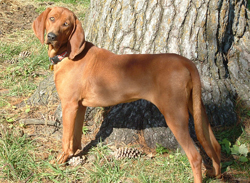Redbone Coonhounds have lean, muscular frames and flashy, red coats. Their smooth, short, coarse coats may also have black and white patches, although solid red is preferred. The breed's eyes are hazel to dark brown, and the ears hang low. These dogs have a square muzzle and black nose. Redbone Coonhounds measure 21 to 27 inches tall at the shoulder and weigh 45 to 80 pounds.
Even though they have an independent nature and are active dogs, Redbone Coonhounds make gentle, playful, and well-mannered companions.
Even-tempered, eager to please, and trainable, Redbone Coonhounds make good family pets. Their smooth coat requires minimal grooming, but the breed needs lots of outdoor activity. These dogs do best in rural areas with active families.
The Redbone Coonhound takes its name from the rich, red coloring of its coat. The breed starred in the popular book "Where the Red Fern Grows" by Wilson Rawls. The dogs in the book, Little Ann and Old Dan, were both Redbone Coonhounds.
Even though they have an independent nature and are active dogs, Redbone Coonhounds make gentle, playful, and well-mannered companions. This is especially true if they are properly socialized and given plenty of opportunity to exercise. These dogs get along well with children, but younger Redbones may be too rambunctious for toddlers.
This breed craves human companionship and may become lonely and depressed without regular company. It is never a good idea to leave these dogs in the yard all day, and they should always sleep inside with their human family members.
Redbone Coonhounds usually get along decently with cats, provided they are raised together, but the breed's very strong desire to chase small animals may put unfamiliar cats and other furry critters in harm's way. These dogs should always be contained in a securely fenced yard or held on a tight leash when outdoors to prevent them from running off after a scent.
Redbone Coonhounds are generally healthy, but the breed is prone to developing a few health conditions that can negatively affect quality or length of life. Hip dysplasia is common in the breed, and hypothyroidism is another concern that is manageable with professional care and medication. Redbones are also prone to certain eye problems, including progressive retinal atrophy. This condition leads to blindness.
Because Redbones are prone to ear infections, their ears should be kept clean and dry at all times. Weekly ear checks are very important in this breed. Additionally, these dogs are at increased risk for becoming obese. Care should be taken to offer measured portions and to provide plenty of opportunity for exercise. Obesity in dogs increases the risk of heart disease, diabetes, arthritis, and some cancers.
With regular exercise, proper nutrition, routine veterinary care, and timely vaccinations, Redbone Coonhounds generally live 10 to 12 years.
Redbone Coonhounds are stubborn dogs with independent minds that like doing things in their own way and time. However, they are still relatively easy to train. Patience and positive reinforcement are key; food rewards work especially well with these dogs. Training should begin as early in life as possible.
To be fully effective, training sessions should be kept short and fun. Redbones have short attention spans and bore easily, and overly long or repetitive sessions will cause these dogs to tune out. Unfortunately, like other hounds, Redbones tend to put their own spin on obedience lessons and may be creative in their interpretation of commands.
Without training, these dogs can be stubborn, resistant, and loud. Their voice carries and may annoy neighbors. These dogs must be taught when it is appropriate for them to be vocal and when it is not. Additionally, Redbone Coonhounds should be taught they cannot always get their way. They must learn who is in control.
The Redbone Coonhound's smooth coat is easy to care for and requires only weekly brushing with a rubber curry brush or hound mitt. This will keep the skin healthy and control shedding. If shedding becomes a problem, more frequent brushing will remove loose hair from the coat before it ends up on clothing and furniture.
Frequent bathing is not usually necessary, although a gentle canine shampoo is beneficial should the Redbone Coonhound roll around in something sticky or stinky. Bathing can also help control the musty scent that Redbones and other coonhounds are known for. Bathing will not completely remove the scent, however; it will only reduce its power. Anyone truly bothered by musky dog odor should reconsider purchasing or adopting one of these dogs.
The nails need clipping every couple of weeks or more often if necessary to keep them from clicking against the floor. Additionally, the ears need checking every week for excess wax accumulation or signs of infection, such as redness, odor, and discharge. Daily tooth brushing is important to prevent tooth decay, gum disease, and bad breath.
Redbone Coonhounds are one of the few breeds that can claim to be made in America. During the late 18th century, Scottish immigrants brought a number of red foxhounds with them to the United States. At some point following the Civil War, hunters mixed these foxhounds with Red Irish Foxhounds and other breeds to create the Redbone Coonhound. The man who contributed the most to the breed's development was George E. L. Birdsong, a dog breeder and foxhunter from Georgia.
Redbones quickly became known for their natural treeing instinct, fast speed, and game-tracking abilities. They could move quickly over very rough terrain, which made them a tremendous asset when hunting in forests and around rivers.
Early Redbone Coonhounds were sometimes called "Saddlebacks" due to the black saddle marking on their backs. Over time, the saddle marking disappeared as breeders selected for a solid red color. Today, these dogs are popular companion animals, especially among people who like their "Made in the USA" status.
In 2009, the American Kennel Club officially recognized the Redbone Coonhound breed.

